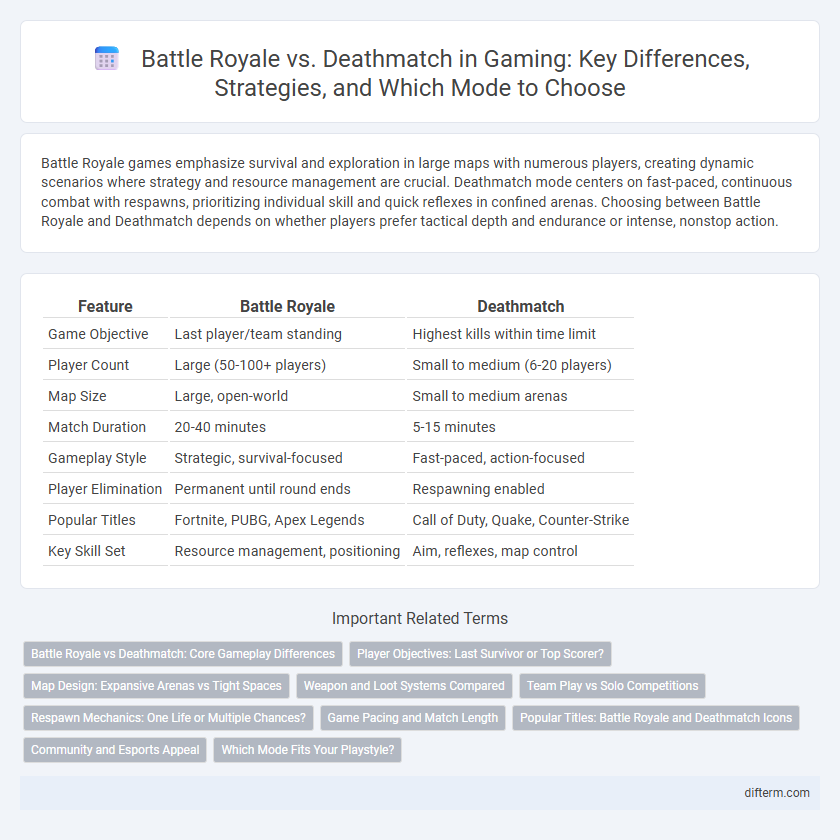Battle Royale games emphasize survival and exploration in large maps with numerous players, creating dynamic scenarios where strategy and resource management are crucial. Deathmatch mode centers on fast-paced, continuous combat with respawns, prioritizing individual skill and quick reflexes in confined arenas. Choosing between Battle Royale and Deathmatch depends on whether players prefer tactical depth and endurance or intense, nonstop action.
Table of Comparison
| Feature | Battle Royale | Deathmatch |
|---|---|---|
| Game Objective | Last player/team standing | Highest kills within time limit |
| Player Count | Large (50-100+ players) | Small to medium (6-20 players) |
| Map Size | Large, open-world | Small to medium arenas |
| Match Duration | 20-40 minutes | 5-15 minutes |
| Gameplay Style | Strategic, survival-focused | Fast-paced, action-focused |
| Player Elimination | Permanent until round ends | Respawning enabled |
| Popular Titles | Fortnite, PUBG, Apex Legends | Call of Duty, Quake, Counter-Strike |
| Key Skill Set | Resource management, positioning | Aim, reflexes, map control |
Battle Royale vs Deathmatch: Core Gameplay Differences
Battle Royale games feature large-scale, last-player-standing mechanics with gradually shrinking play zones, emphasizing survival, resource management, and strategic positioning. Deathmatch modes focus on fast-paced, continuous combat where the primary objective is to achieve the highest number of kills within a set time or score limit. The core gameplay difference lies in Battle Royale's emphasis on long-term strategy and exploration versus Deathmatch's focus on immediate combat intensity and quick respawns.
Player Objectives: Last Survivor or Top Scorer?
Battle Royale games emphasize the objective of being the last survivor by eliminating all other players while managing resources and strategic positioning. Deathmatch modes prioritize achieving the highest kill count within a set time or score limit, focusing on fast-paced combat and reflexes. Both modes challenge players differently: survival strategy in Battle Royale versus aggressive, consistent kills in Deathmatch.
Map Design: Expansive Arenas vs Tight Spaces
Battle royale games feature expansive maps designed for strategic exploration, resource gathering, and large-scale combat, encouraging players to utilize diverse terrain and long-range tactics. Deathmatch modes emphasize tight spaces with compact, intricate layouts that promote fast-paced action, close-quarters combat, and frequent player encounters. Map design in battle royale prioritizes player survival across vast environments, whereas deathmatch focuses on immediate engagement and quick reflexes within confined arenas.
Weapon and Loot Systems Compared
Battle royale games feature extensive, randomized loot systems with a wide array of weapons and gear scattered across large maps, encouraging exploration and strategic resource management. Deathmatch modes typically offer fixed or respawned weapon pickups, emphasizing immediate combat and skill-based weapon mastery rather than scavenging. This difference in weapon and loot availability directly impacts gameplay pacing and player decision-making dynamics.
Team Play vs Solo Competitions
Battle royale games emphasize team play, requiring coordinated strategies, communication, and resource sharing to survive against multiple squads in expansive environments. Deathmatch modes prioritize solo competition, demanding individual skill, reflexes, and quick decision-making to achieve the highest kill count within limited arenas. Team-based battle royales foster collaboration and tactical planning, while deathmatches test singular player prowess and adaptability under pressure.
Respawn Mechanics: One Life or Multiple Chances?
Battle royale games emphasize high stakes by offering players only one life per match, intensifying strategic play and tension. In contrast, deathmatch modes provide multiple respawns, encouraging fast-paced action and continuous engagement. These different respawn mechanics significantly shape player behavior and game pacing in competitive gaming.
Game Pacing and Match Length
Battle royale games typically feature longer match lengths, often lasting 20 to 30 minutes, emphasizing strategic pacing and survival tactics over extended periods. Deathmatch modes prioritize fast-paced, intense gameplay with shorter rounds that usually range from 5 to 10 minutes, encouraging quick reflexes and frequent player engagements. The contrasting game pacing between battle royale and deathmatch directly influences player decision-making and overall match dynamics.
Popular Titles: Battle Royale and Deathmatch Icons
Call of Duty: Warzone and Apex Legends dominate the battle royale genre with expansive maps and survival-based gameplay, attracting millions of players worldwide. In contrast, Counter-Strike: Global Offensive and Call of Duty: Modern Warfare excel in deathmatch modes, emphasizing fast-paced, team-based combat and skillful gunplay. These titles set the standard for their respective genres by combining competitive mechanics with engaging multiplayer experiences.
Community and Esports Appeal
Battle royale games foster large, dynamic communities with intense competition, attracting millions of players worldwide and creating massive spectator audiences for esports events like Fortnite and Apex Legends. Deathmatch modes offer fast-paced, skill-based gameplay that appeals to competitive players seeking quick matches and refined mechanics, making games like Call of Duty and Counter-Strike staples in esports tournaments. The contrasting formats cater to different esports demographics: battle royale prioritizes survival strategy and scale, while deathmatch emphasizes individual skill and reflexes, shaping community engagement and event structures accordingly.
Which Mode Fits Your Playstyle?
Battle Royale suits players who enjoy strategic planning, exploration, and survival tactics across large maps with numerous opponents. Deathmatch appeals to gamers seeking fast-paced action, intense combat, and quick respawns for constant engagement. Choosing between these modes depends on whether you prefer prolonged, tactical gameplay or rapid, skill-based encounters.
battle royale vs deathmatch Infographic

 difterm.com
difterm.com